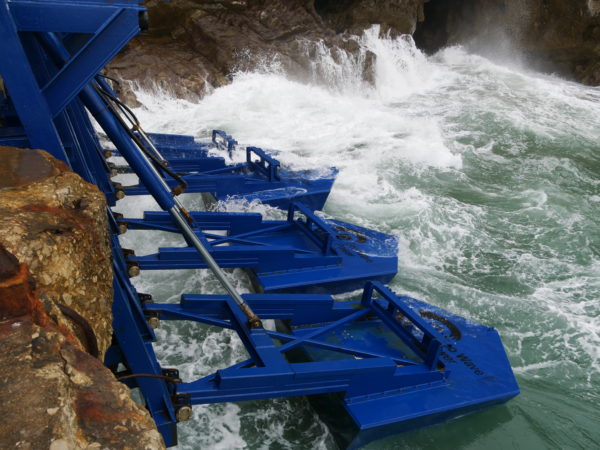“By focusing on this new technology, the United States could be the leader in an entire subset of the energy spectrum.”
The sun doesn’t always shine, and the wind doesn’t always blow, but there’s always motion in the ocean. And that is good news for California’s energy future.
At a time when both our planet and our politics demand that we look at new ways to power our world, AltaSea and Eco Wave Power are collaborating to bring wave energy to Los Angeles. Using a patented smart and cost-efficient technology for turning ocean and sea waves into green electricity, Eco Wave Power’s mission is to assist in the fight against climate change by enabling commercial power production from the ocean and sea waves.
PROVEN SUSTAINABILITY
Wave energy comes in many forms: Some use the bobbing up-and-down motion of waves to generate energy in a motion similar to a piston; others store water during high tide and then release it during low tide like a dam.
But regardless of the specific technology, California’s 840-mile-long shoreline holds the promise of unlocking an untapped power source that could provide much of the energy we need to power our homes and businesses every day.
In fact, according to the U.S. Energy Information Administration, the annual energy potential of waves off the coasts of the United States is estimated to be as much as 2.64 trillion kilowatt hours, or the equivalent of about 66% of all the electricity generated across the country in 2020.

Eco Wave Power’s pilot system in action in Gibraltar, where it has already logged over 49,632 grid connection hours. Image source: Eco Wave Power.
The best part is that we know these systems work. Eco Wave Power has accumulated almost six years of operational experience with over 49,632 grid-connection hours at its pilot site in Gibraltar, proving that wave energy can safely connect to the grid and withstand the massive storms for which Gibraltar is known.
INVESTING IN U.S. WAVE ENERGY
Now, it is time for us to invest in wave energy here in the U.S. in the same way we have committed to wind and solar.
By focusing on this new technology, the United States could be the leader in an entire subset of the energy spectrum. American engineers could lead the research for more efficient energy modules. American manufacturers could be the main producer of wave- energy systems and the batteries that store the energy. But we need to make wave energy a priority.
As a nation, we are already deeply invested in renewable energy. Renewables made up as much as 57% of new capacity in the United States in 2020, but we are still struggling with keeping the lights on during prolonged heat waves and wildfires that force rolling blackouts and “Flex Alerts” throughout California each summer.
Wave energy is exciting. It is renewable. And it doesn’t stop when the sun goes down or the air is still. Projects like the one AltaSea and Eco Wave Power have launched in Los Angeles will help steer our country toward energy independence and away from the dirty and expensive energy of the past. That is the wave of the future.
Terry Tamminen is the President and CEO of AltaSea, the world’s leading destination for the Blue Economy.
Inna Braverman is founder and CEO of Eco Wave Power. The Swedish company has developed and patented cost-efficient wave energy technology.
Click here to view the original article.

Greetings,
I am with the National Renewable Energy Laboratory and we are working in partnership with DOE’s Water Power Technologies Office and the Hydropower Foundation to develop a baseline workforce report on water power professionals in the marine energy industry. We would love to schedule a time to talk with a representative from your organization about workforce demographics and challenges in a one-hour meeting.
We are conducting outreach to get a better understanding of the U.S. marine energy workforce by collecting data that will provide an overview of U.S. marine energy projects, technologies and workforce. The technological scope will include wave, tidal, ocean, ocean thermal, river and salinity gradient technologies. Your responses will be strictly confidential and data from this research will be reported only in the aggregate. We will provide generalizations about the state of the marine energy industry in the report.
We look forward to speaking with you!
Best, Maddy